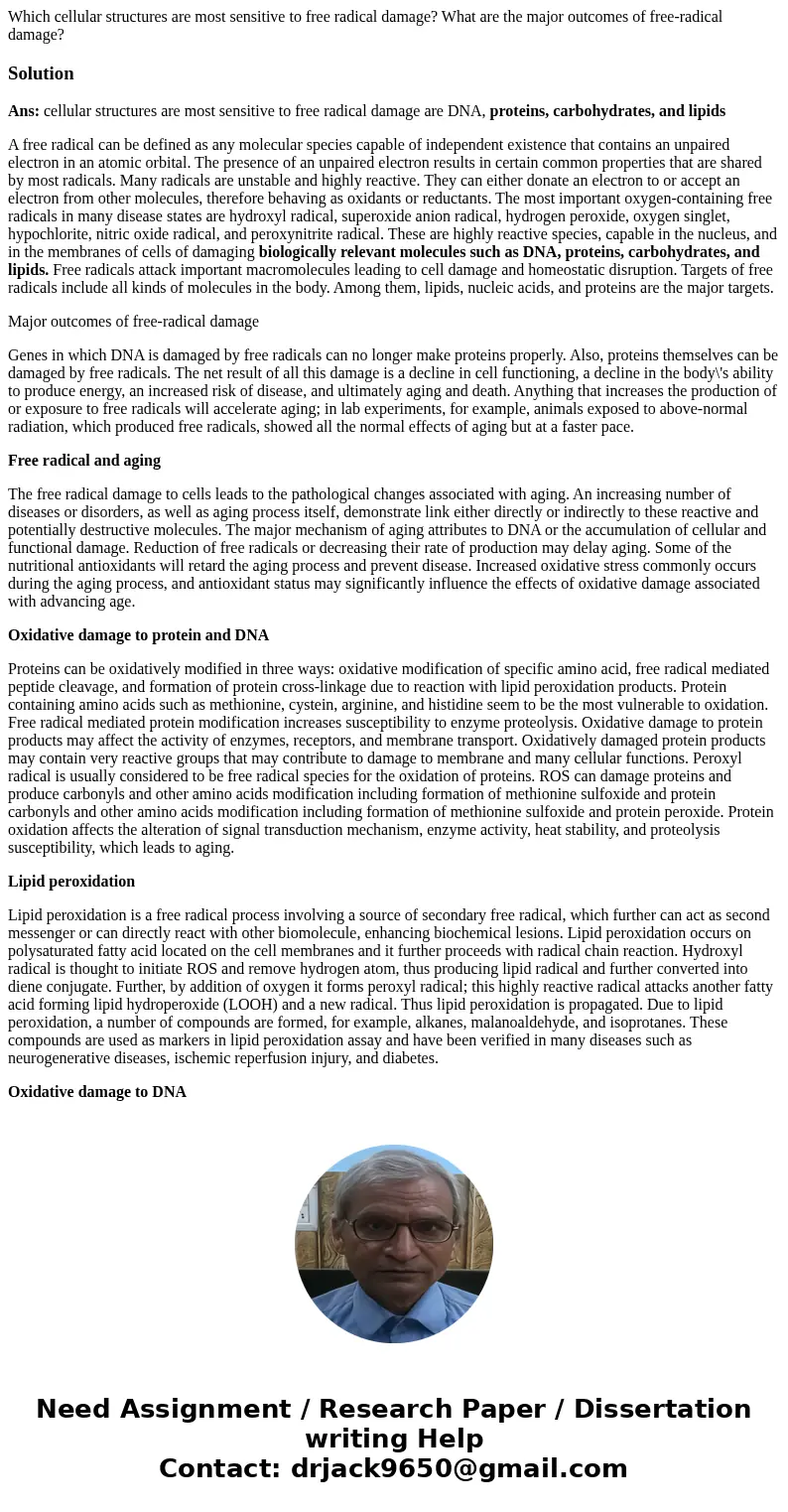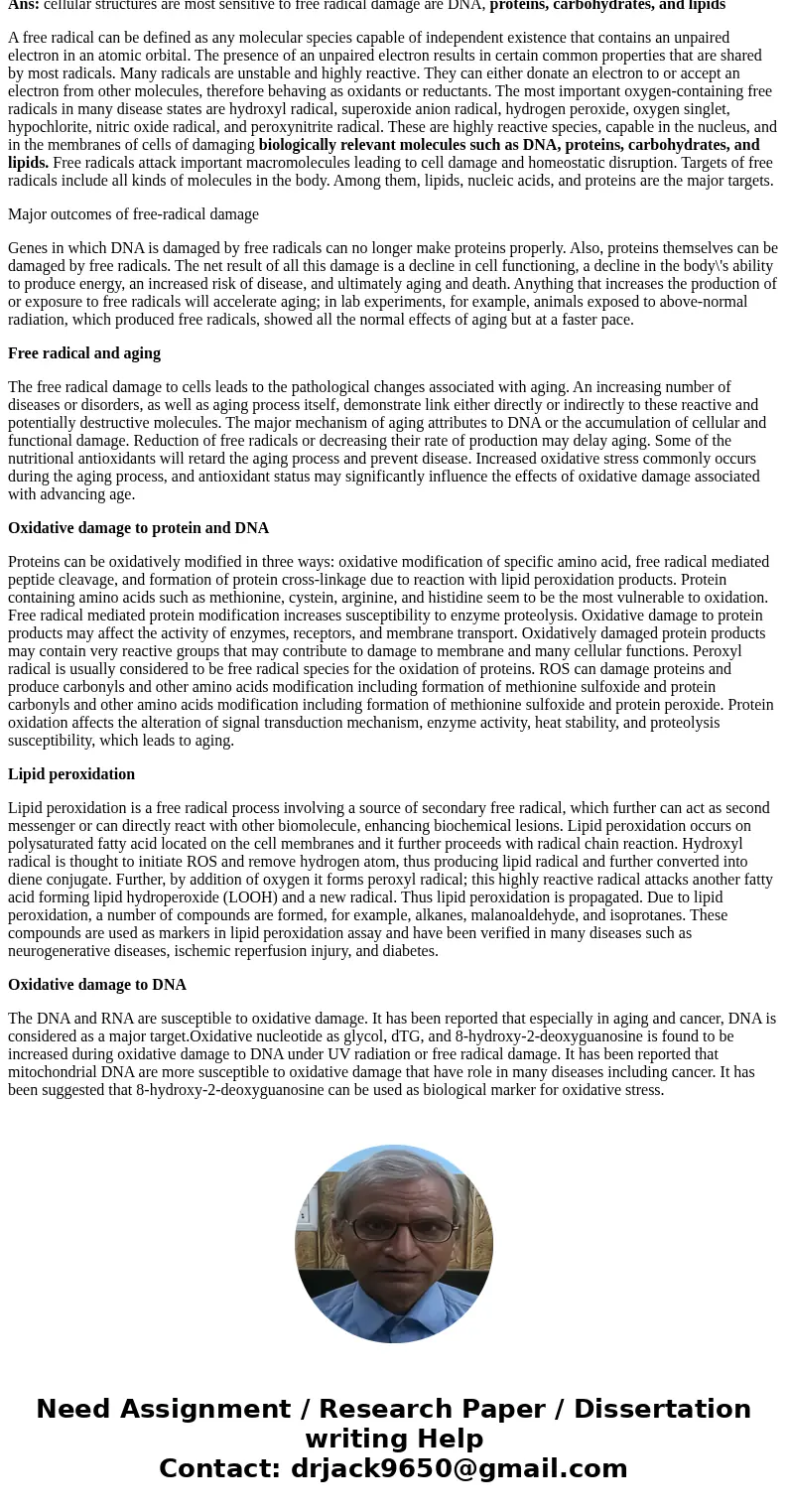Which cellular structures are most sensitive to free radical
Which cellular structures are most sensitive to free radical damage? What are the major outcomes of free-radical damage?
Solution
Ans: cellular structures are most sensitive to free radical damage are DNA, proteins, carbohydrates, and lipids
A free radical can be defined as any molecular species capable of independent existence that contains an unpaired electron in an atomic orbital. The presence of an unpaired electron results in certain common properties that are shared by most radicals. Many radicals are unstable and highly reactive. They can either donate an electron to or accept an electron from other molecules, therefore behaving as oxidants or reductants. The most important oxygen-containing free radicals in many disease states are hydroxyl radical, superoxide anion radical, hydrogen peroxide, oxygen singlet, hypochlorite, nitric oxide radical, and peroxynitrite radical. These are highly reactive species, capable in the nucleus, and in the membranes of cells of damaging biologically relevant molecules such as DNA, proteins, carbohydrates, and lipids. Free radicals attack important macromolecules leading to cell damage and homeostatic disruption. Targets of free radicals include all kinds of molecules in the body. Among them, lipids, nucleic acids, and proteins are the major targets.
Major outcomes of free-radical damage
Genes in which DNA is damaged by free radicals can no longer make proteins properly. Also, proteins themselves can be damaged by free radicals. The net result of all this damage is a decline in cell functioning, a decline in the body\'s ability to produce energy, an increased risk of disease, and ultimately aging and death. Anything that increases the production of or exposure to free radicals will accelerate aging; in lab experiments, for example, animals exposed to above-normal radiation, which produced free radicals, showed all the normal effects of aging but at a faster pace.
Free radical and aging
The free radical damage to cells leads to the pathological changes associated with aging. An increasing number of diseases or disorders, as well as aging process itself, demonstrate link either directly or indirectly to these reactive and potentially destructive molecules. The major mechanism of aging attributes to DNA or the accumulation of cellular and functional damage. Reduction of free radicals or decreasing their rate of production may delay aging. Some of the nutritional antioxidants will retard the aging process and prevent disease. Increased oxidative stress commonly occurs during the aging process, and antioxidant status may significantly influence the effects of oxidative damage associated with advancing age.
Oxidative damage to protein and DNA
Proteins can be oxidatively modified in three ways: oxidative modification of specific amino acid, free radical mediated peptide cleavage, and formation of protein cross-linkage due to reaction with lipid peroxidation products. Protein containing amino acids such as methionine, cystein, arginine, and histidine seem to be the most vulnerable to oxidation. Free radical mediated protein modification increases susceptibility to enzyme proteolysis. Oxidative damage to protein products may affect the activity of enzymes, receptors, and membrane transport. Oxidatively damaged protein products may contain very reactive groups that may contribute to damage to membrane and many cellular functions. Peroxyl radical is usually considered to be free radical species for the oxidation of proteins. ROS can damage proteins and produce carbonyls and other amino acids modification including formation of methionine sulfoxide and protein carbonyls and other amino acids modification including formation of methionine sulfoxide and protein peroxide. Protein oxidation affects the alteration of signal transduction mechanism, enzyme activity, heat stability, and proteolysis susceptibility, which leads to aging.
Lipid peroxidation
Lipid peroxidation is a free radical process involving a source of secondary free radical, which further can act as second messenger or can directly react with other biomolecule, enhancing biochemical lesions. Lipid peroxidation occurs on polysaturated fatty acid located on the cell membranes and it further proceeds with radical chain reaction. Hydroxyl radical is thought to initiate ROS and remove hydrogen atom, thus producing lipid radical and further converted into diene conjugate. Further, by addition of oxygen it forms peroxyl radical; this highly reactive radical attacks another fatty acid forming lipid hydroperoxide (LOOH) and a new radical. Thus lipid peroxidation is propagated. Due to lipid peroxidation, a number of compounds are formed, for example, alkanes, malanoaldehyde, and isoprotanes. These compounds are used as markers in lipid peroxidation assay and have been verified in many diseases such as neurogenerative diseases, ischemic reperfusion injury, and diabetes.
Oxidative damage to DNA
The DNA and RNA are susceptible to oxidative damage. It has been reported that especially in aging and cancer, DNA is considered as a major target.Oxidative nucleotide as glycol, dTG, and 8-hydroxy-2-deoxyguanosine is found to be increased during oxidative damage to DNA under UV radiation or free radical damage. It has been reported that mitochondrial DNA are more susceptible to oxidative damage that have role in many diseases including cancer. It has been suggested that 8-hydroxy-2-deoxyguanosine can be used as biological marker for oxidative stress.


 Homework Sourse
Homework Sourse